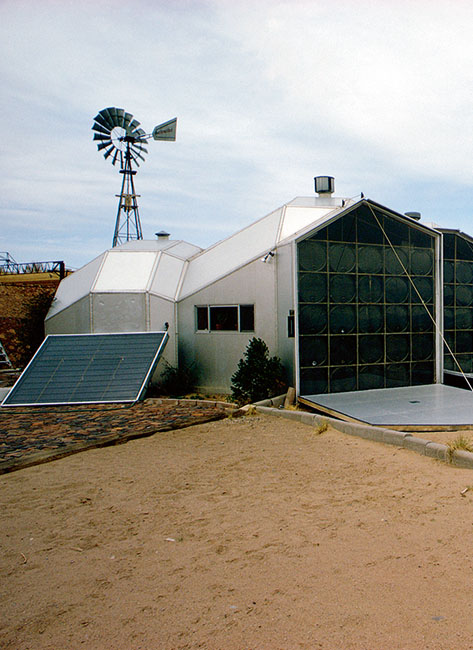Zome House Corrales, New Mexico
Abstract
In 1966, after having taken various courses at UCLA in California and Amherst College in Massachusetts, doing a few years of service at an American army base in Germany and studying for several years at the ETH in Zurich, Steve Baer returned to the USA. He was fascinated by polyhedral forms, with which he had experimented while working as a welder in a metal shop, and came in contact with the artists who founded Drop City in Trinidad, Colorado. At that point he had more building experience than most of the ‘Droppers’ did, which led to his publishing the Dome Cookbook in 1968. Baer developed the ‘zome’ (a combination of ‘zonohedron’ and ‘dome’), a structure which, unlike a dome, can be elongated or linked in several directions. The first zomes were built in Drop City, with their façades usually consisting of the flattened tops of old cars.
After Drop City fell apart, Steve and his wife Holly started building their own zome in Corrales, New Mexico in 1971. The U-shaped house consists of 11 linked zomes that surround a patio, which opens to the east on account of the hot climate. The interior walls are made of adobe, and exterior skin consist of light, strong and well-insulating aluminium sandwich panels glued onto a cardboard honeycomb. They are injected with polyurethane foam on both sides so that a small air cavity remains in the middle. On the inside of the exterior walls, adobe walls were also gradually erected. Throughout the years, layers of insulation and sheeting were added to the façade, until finally a finishing layer of stucco was applied.
The house is full of passive solar energy systems, for the greater part developed or improved by Steve and Holly. The most well known is the ‘Drum Wall’. This heat-accumulating wall consists of water-filled oil drums mounted in a steel rack behind glass panels facing south. In front of them is a hinged aluminium sandwich panel that can be handily raised or lowered. In the winter, the panels are open in the daytime and the sun heats up the water, with the lowered panels functioning as reflectors. The concrete floor and the adobe walls contribute to the accumulation of surplus heat during the day. At night, the insulating panels are raised and the heated wall of water radiates the heat that it has collected into the interior spaces. In the summer, the process works the other way around.



